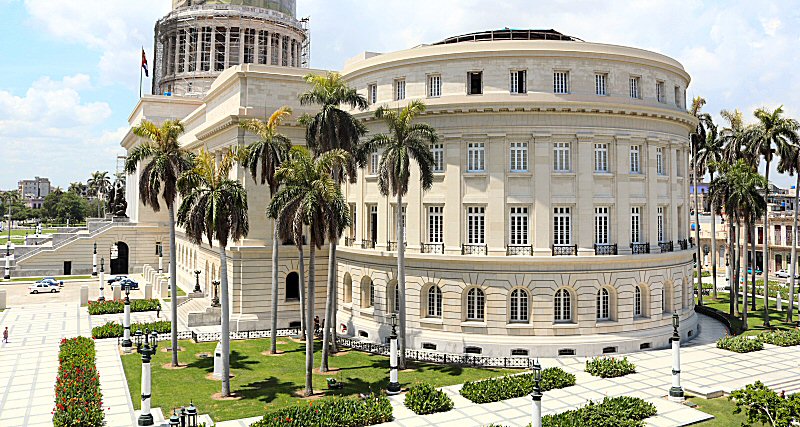
There are two inner courtyards in
the building, located in the center of each wing and adorned
with sculptures. They provide light and ventilation to the
offices on the ground floor. The inner courtyard of the
north wing contains the statue of Mephistopheles, the angel
known also as Lucifer. The statue is called El Ángel Rebelde
(the Rebellious Angel) and it is the work of the Sicilian
artist Salvatore Buemi. It was brought from Italy to Cuba by
the politician Orestes Ferrara that donated it to the
building in 1932. Unlike the effigies erected to Lucifer in
the world in that he always appears defeated and humiliated,
this statue in El Capitolio is unique in the world by
representing the angel defiantly and arrogantly. His right
arm is raised toward the sky and his fist is closed
demonstrating a rebellious attitude. With his left hand he
points to himself, requesting people to follow only him.
The
basement of the building that is just below the Hall of Lost
Steps, is restored to a space to pay tribute to the martyrs
of the struggle for the independence of Cuba. The project
was part of the work of the architect Félix Cabarrocas and
it was built under the direction of the architect Eugenio
Raynieri Piedra. The visitors can access this place through
the gate below the stairway on the right side. In the center
of the hall you will see a hexagonal star on the marble
floor. In its center an eternal flame is placed that is
perfectly aligned on a vertical axis through the diamond on the
ground of the Hall of the Lost Steps and the center of the
cupola. Opposite to the eternal flame, a marble sarcophagus
preserves the remains of an unknown mambí, brought from the
Pantheon of the Veterans of the Independence of the Cemetery
of Columbus. On the sarcophagus it is written
Al Mambí Desconocido (To the unknown Mambí).
At its feet a wreath stands out that is renewed every week
as the offering of the President.
The cenotaph is
surrounded by the flags of the Latin American nations.
In a niche opposite the sarcophagus you will
see the marble replica of the Estatua de la Republica.
At the walls you can see the bronze
national shield of Cuba, the notes of the anthem Bayamo,
composed by Pedro Perucho Figueredo Cisneros,
and the words of Carlos Manuel de Céspedes when
he was proclaimed President in the Assembly of Guaimaro in
1869.
